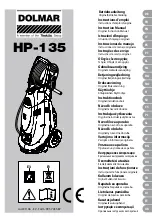
Food Preparation
1) Add food and liquid into the pressure cooker. Close cover (as shown above) and
begin cooking over low-medium heat. Lower heat settings help to prevent food
from sticking within the cooker body.
2) The auto-lock valves are the red rods, located on each of the top handles. As the
pressure cooker heats and pressure builds, the auto-lock valves rise automatically.
Once the auto-lock valves are raised, there is pressure inside the cooker and the
pressure cooker cover cannot be opened. If the auto-lock valves are not raised,
there is no pressure inside the pressure cooker and you can safely open the lid.
3) As the food begins to heat, air in the pressure cooker will escape through the
pressure release valve causing the valve knob to rise. The release of the steam will
create a low hissing sound, which is normal.
4) When the auto-lock valves and the pressure release valve start working, it is natural
that a little steam comes out from them.
5) Continue to cook until the first red ring becomes visible on the pressure release
valve stem. At this point, lower the temperature if level 1 (45-55 kPa or 6.5-8 psi)
is the recommended cooking level for the food you are cooking. If the
recommended cooking level is level 2 (72-88 kPa or 10.4-13 psi), allow the food to
continue to cook over medium heat until the second red ring becomes visible on
the pressure release valve stem.
Cooking level 1 is reached when the first red ring is visible on the
pressure release valve stem. Level 1 cooks foods gently at a low
cooking pressure. This position should be used for cooking
delicate foods such as fish or vegetables.
Cooking level 1
(LOW)
45-55 kPa
(6.5-8 psi)
Cooking level 2 is reached when the 2nd red ring becomes visible
on the pressure release valve stem. Level 2 cooks at a high
cooking pressure. This position should be used for cooking
recipes such as stews, soups, meat, etc.
Cooking level 2
(HIGH)
72-88 kPa
(10.4-13psi)
SAVE THESE INSTRUCTIONS
9
TICINOBOOKLET ENGLISH_Mise en page 1 2013-10-15 15:26 Page11






































